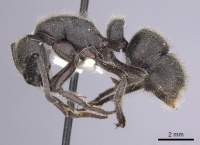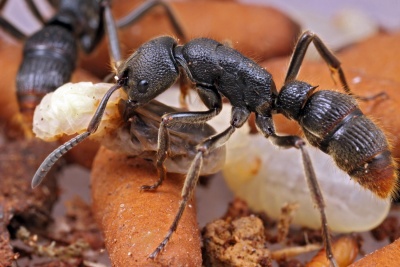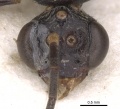Pseudoneoponera
| Pseudoneoponera | |
|---|---|

| |
| Pseudoneoponera excavata | |
| Scientific classification | |
| Kingdom: | Animalia |
| Phylum: | Arthropoda |
| Class: | Insecta |
| Order: | Hymenoptera |
| Family: | Formicidae |
| Subfamily: | Ponerinae |
| Tribe: | Ponerini |
| Alliance: | Odontomachus genus group |
| Genus: | Pseudoneoponera Donisthorpe, 1943 |
| Type species | |
| Pseudoneoponera verecundae | |
| Diversity | |
| 29 species (Species Checklist, Species by Country) | |
Pseudoneoponera is comprised of less than 20 species and ranges from India to Australia. The genus is notable for the unusual foamy defensive secretions its workers exude from the sting, for its small colonies, and for its unusual social systems, including the frequent occurrence of gamergates.
| At a Glance | • Gamergate |
Identification
Schmidt and Shattuck (2014) - Workers of Pseudoneoponera are distinguished from other ponerines by their combination of robust build, coarse sculpturing, shaggy pilosity, obsolete metanotal groove, a nodiform petiole which is semicircular in dorsal view and often has a denticulate posterodorsal margin, longitudinally striate tergite A3 (rarely otherwise sculptured), and strong gastral constriction between A3 and A4. Pseudoneoponera most closely resembles Bothroponera and Phrynoponera, and to a lesser extent Ectomomyrmex, but these genera lack the shaggy pilosity, semicircular denticulate petiole, and longitudinally striate tergite A3 of Pseudoneoponera, and Pseudoneoponera lacks the spinose propodeum (except Pseudoneoponera bispinosa), five-spined petiolar node, and unconstricted gaster of Phrynoponera, and the small eyes, angular sides of the head, divided mesopleuron (except in a few species), and weakly constricted gaster of Ectomomyrmex.
Keys including this Genus
- Key to Australian Genera of Ponerinae
- Key to Eurasian and Australian Genera of Ponerinae
- Key to Vietnamese Ponerinae Genera
Distribution
Pseudoneoponera occurs from India through Southeast Asia to Australia, where it reaches its greatest species diversity. At least one species, Pseudoneoponera rufipes, ranges all the way from India to Australia.
Distribution and Richness based on AntMaps
Species by Region
Number of species within biogeographic regions, along with the total number of species for each region.
| Afrotropical Region | Australasian Region | Indo-Australian Region | Malagasy Region | Nearctic Region | Neotropical Region | Oriental Region | Palaearctic Region | |
|---|---|---|---|---|---|---|---|---|
| Species | 0 | 16 | 11 | 0 | 0 | 0 | 5 | 2 |
| Total Species | 2841 | 1736 | 3045 | 932 | 835 | 4379 | 1741 | 2862 |
Biology
Pseudoneoponera has received a fair bit of attention from researchers due to its unusual reproductive and social strategies. While most species have not been carefully surveyed, the queen caste has apparently been found in only a few species, while gamergates have been found in several species (Monnin & Peeters, 2008). In at least two species, both queens and gamergates may cohabit a single colony (see below). Just how widespread reproduction by gamergates is in Pseudoneoponera is unknown, but it may be characteristic of much or most of the genus. Interestingly, queens are unknown from all Australian Pseudoneoponera species, having only been found in some Indonesian species. It is tempting to think that the complete loss of the queen caste may be synapomorphic for the Australian species, but too little is known about relationships within the genus to test this hypothesis.
Pseudoneoponera species studied to date all have very small colonies (roughly 10 to 20 workers; Ito, 1993; Peeters et al., 1991; Ito & Higashi, 1991; Higashi et al., 1994; Sommer et al., 1994). Peeters et al (1991) report that Pseudoneoponera sublaevis workers forage individually and prey on insects, and Shivashankar et al. (1995) report that Pseudoneoponera rufipes feeds on a wide diversity of arthropods and other invertebrates, but otherwise few direct observations of Pseudoneoponera feeding have been published. Presumably these ants are generalist predators and scavengers, like most ponerines.
An unusual characteristic of this genus is that workers produce a foamy thread-like defensive excretion from their venom glands. This has been observed in at least Pseudoneoponera bispinosa, Pseudoneoponera insularis, Pseudoneoponera rufipes, Pseudoneoponera sublaevis, and Pseudoneoponera tridentata (Bingham, 1903; Maschwitz et al., 1981; Peeters et al., 1991; Sommer et al., 1994). The foaming is made possible by the atrophication of the Dufour’s gland and the resulting mixing of venom gland proteins with air (Maschwitz et al., 1981; Buschinger & Maschwitz, 1984). The report by Bingham (1903) that P. bispinosa and P. rufipes release the foam from their mouths is almost certainly a misinterpretation of the phenomenon, as suggested by Maschwitz et al. (1981); indeed, one of us (CS) personally witnessed a P. rufipes worker emit foam from the tip of its abdomen. Maschwitz et al. (1981) report that P. insularis and P. tridentata retain a normal sting response, in addition to the foaming mechanism, and that their sting is painful. They hypothesize (and provide supporting experimental evidence) that the foaming mechanism is more effective than the sting against small fast moving enemies such as other ants. The foam apparently acts as a physical obstacle requiring active cleaning rather than as a neurotoxin (Buschinger & Maschwitz, 1984). A similar foamy secretion has been independently evolved by at least one species of Pachycondyla (Pachycondyla harpax; Overal, 1987).
P. tridentata has an unusual social system in which colonies can have both multiple dealate queens and multiple gamergates, which compete with each other for reproductive dominance (Sommer & Hölldobler, 1992). Some colonies lack queens, in which case reproduction is performed solely by gamergates. A large proportion of both queens and workers in a colony are mated (47–100% and 81–100%, respectively; Sommer et al., 1994), and multiple individuals can be reproductively active. Since so many individuals in a colony are mated, reproduction seems to be correlated with age and behavioral dominance rather than with mating status. Workers apparently mate with males produced by their own colony, while queens do not (Sommer et al., 1994). Colony founding in P. tridentata may occur via several different mechanisms, including pleiometrosis and fission (Hölldobler et al., 1992; Sommer et al., 1994). Tandem recruitment is used during nest emigration (Maschwitz et al., 1981). Workers of P. tridentata forage individually at night, and nesting generally occurs in the ground, though nests have also been found in trees (Maschwitz et al., 1981; Sommer et al., 1994). Jessen & Maschwitz (1983) found that P. tridentata is endowed with a large number of abdominal glands whose functions are unknown.
Ito (1993, 1999) studied the reproductive strategy of an undescribed Pseudoneoponera species in Java. This species is unusual in that multiple mated workers may be present in a colony, but only the top-ranked worker is a gamergate (Ito 1993). Queens do occur, but most colonies are apparently queenless and have around 10 workers, of which one or more are mated (Ito 1993). The workers in a colony are ranked in a dominance hierarchy structured via frequent antagonistic interactions; low-ranking workers are the principal foragers (Ito, 1993). Males attempt to mate with their nestmates but are usually rejected; mating only occurs with foreign males, and only when a gamergate is absent (Ito, 1999).
Pseudoneoponera sublaevis also reproduces via gamergates, but in yet another variation on the theme, only a single worker in the colony is mated and performs all reproduction for the colony (Ito & Higashi, 1991; Peeters et al., 1991). The members of a colony are organized in a strict linear hierarchy determined by age and by ritualized dominance displays, and queens are apparently absent (Higashi et al., 1994). This species occurs in Australian Eucalyptus forests, and nests in the ground (Peeters et al., 1991). Gamergates are also known to occur in Pseudoneoponera porcata (Peeters, 1993), but the details of its mating system are unknown.
An unidentified species of Pseudoneoponera is a model for the mimetic staphylinid beetle Naddia sp. (Bhattacharjee et al., 2023).
Life History Traits
- Mean colony size: ~10 (Greer et al., 2021)
- Compound colony type: not parasitic (Greer et al., 2021)
- Nest site: hypogaeic; arboreal (Greer et al., 2021)
- Diet class: predator (Greer et al., 2021)
- Foraging stratum: subterranean/leaf litter; arboreal (Greer et al., 2021)
- Foraging behaviour: solitary (Greer et al., 2021)
Castes
Male
Morphology
Worker Morphology
 Explore: Show all Worker Morphology data or Search these data. See also a list of all data tables or learn how data is managed.
Explore: Show all Worker Morphology data or Search these data. See also a list of all data tables or learn how data is managed.
• Eyes: >100 ommatidia • Pronotal Spines: absent • Mesonotal Spines: absent • Propodeal Spines: absent • Petiolar Spines: absent; dentiform • Caste: none or weak • Sting: present • Metaplural Gland: present • Cocoon: present
Karyotype
Species Uncertain
- Pseudoneoponera sp.(ANIC-2): n = 30, 2n = 60, karyotype = 36M + 24A (Australia) (Imai et al., 1977; Mariano et al., 2015).
All Karyotype Records for Genus
- See additional details at the Ant Chromosome Database.
 Explore: Show all Karyotype data or Search these data. See also a list of all data tables or learn how data is managed.
Explore: Show all Karyotype data or Search these data. See also a list of all data tables or learn how data is managed.
| Taxon | Haploid | Diploid | Karyotype | Locality | Source | Notes |
|---|---|---|---|---|---|---|
| Pseudoneoponera | 30 | 60 | 36M + 24A | Australia | Imai et al., 1977; Mariano et al., 2015 | |
| Pseudoneoponera rufipes | 24 | 48 | 20M+28A | India | Imai et al., 1984; Mariano et al., 2015 | as ''Bothroponera rufipes'' |
Phylogeny
| Ponerinae |
| |||||||||||||||||||||||||||||||||||||||||||||||||||||||||||||||||||||||||||||||||||||||||||||||||||||||||||||||||||||||||||||||||||||||||||||||||||||||||||||||||||||||||||||||||||||||||||||||||||||||||||||||||||||||||||||||||||||||||||||||||||||||||||||||
See Phylogeny of Ponerinae for details.
Nomenclature
The following information is derived from Barry Bolton's Online Catalogue of the Ants of the World.
- PSEUDONEOPONERA [Ponerinae: Ponerini]
- Pseudoneoponera Donisthorpe, 1943d: 439. Type-species: Pseudoneoponera verecundae, by original designation.
- Pseudoneoponera junior synonym of Bothroponera: Wilson, 1958d: 361.
- Pseudoneoponera junior synonym of Pachycondyla: Snelling, R.R. 1981: 389; Hölldobler & Wilson, 1990: 11; Brown, in Bolton, 1994: 164.
- Pseudoneoponera revived from synonymy: Schmidt & Shattuck, 2014: 131.
Unless otherwise noted the text for the remainder of this section is reported from the publication that includes the original description.
Description
Schmidt and Shattuck (2014):
Worker
Medium to large (TL 9–18 mm) robust ants with the standard characters of Ponerini. Mandibles triangular and usually with a distinct basal groove. Eyes moderate to large in size, placed anterior of head midline. Mesopleuron usually not divided by a transverse groove. Metanotal groove absent. Propodeum broad dorsally, the posterodorsal margin usually unarmed (bispinose in P. bispinosa). Propodeal spiracle slit-shaped. Metatibial spur formula (1s, 1p). Petiole surmounted by a wide node, which is roughly semicircular in dorsal view (the anterior face convex and the posterior face flat or concave), the posterodorsal margin often denticulate (rarely medially incised or trispinose). Gaster with a strong girdling constriction between pre- and postsclerites of A4. Head and body coarsely sculptured, the tergite of A3 usually deeply longitudinally striate. Head and body shaggy, clothed in dense pilosity, which is often reddish in color. Color ferrugineous to black.
Queen
Queens have been formally described only for Pseudoneoponera sandakana (Wheeler, 1919), for which the worker caste is still undescribed. Queens have also been noted to occur in Pseudoneoponera tridentata (Sommer & Hölldobler, 1992) and an undescribed species from Java (Ito, 1993). Gamergates are common in the genus, and the queen caste has apparently been completely lost in many species. From the description of P. sandakana, it appears that queens, when they exist, are similar to workers but are alate and have the typical modifications of the head and thorax found in other alate ponerine queens.
Male
See descriptions in Forel, 1900a, Wheeler (1919), and Donisthorpe (1943a).
Larva
Described by Wheeler & Wheeler (1971b, 1976).
References
- Bhattacharjee, B., Chakrovorty, A., Hava, J., Samadder, A. 2024. A natural history note on the Pseudoneoponera ant-mimicking behaviour of Naddia sp. (Staphylinidae: Staphylininae: Staphylinini: Staphylinina), from Kalyani University campus, Kalyani, Nadia, West Bengal, India. Zootaxa 5399(3), 281–286 (doi:10.11646/zootaxa.5399.3.7).
- Bolton, B. 1994. Identification guide to the ant genera of the world. Cambridge, Mass.: Harvard University Press, 222 pp. (page 164, Pseudoneoponera as junior synonym of Pachycondyla)
- Bolton, B. 2003. Synopsis and Classification of Formicidae. Mem. Am. Entomol. Inst. 71: 370pp (page 168, Pseudoneoponera as junior synonym of Pachycondyla)
- Brown, W. L., Jr. 1973b. A comparison of the Hylean and Congo-West African rain forest ant faunas. Pp. 161-185 in: Meggers, B. J., Ayensu, E. S., Duckworth, W. D. (eds.) Tropical forest ecosystems in Africa and South America: a comparative review. Wash (page 184, Pseudoneoponera as junior synonym of Pachycondyla (provisional))
- Cantone S. 2018. Winged Ants, The queen. Dichotomous key to genera of winged female ants in the World. The Wings of Ants: morphological and systematic relationships (self-published).
- Chapman, J. W.; Capco, S. R. 1951. Check list of the ants (Hymenoptera: Formicidae) of Asia. Monogr. Inst. Sci. Technol. Manila 1: 1-327 (page 77, Pseudoneoponera in Ponerinae, Pseudoneoponerini)
- Donisthorpe, H. 1943e. The ants (Hym., Formicidae) of Waigeu Island, North Dutch New Guinea. Ann. Mag. Nat. Hist. 11(10): 433-475 (page 439, Pseudoneoponera by genus)
- Esteves, F.A., Fisher, B.L. 2021. Corrieopone nouragues gen. nov., sp. nov., a new Ponerinae from French Guiana (Hymenoptera, Formicidae). ZooKeys 1074, 83–173 (doi:10.3897/zookeys.1074.75551).
- Hölldobler, B.; Wilson, E. O. 1990. The ants. Cambridge, Mass.: Harvard University Press, xii + 732 pp. (page 11, Pseudoneoponera as junior synonym of Pachycondyla )
- Ito F & Higashi S. 1991. A linear dominance hierarchy regulating reproduction and polyethism of the queenless ant Pachycondyla sublaevis. Naturwissenschaften 78: 80–82.
- Peeters, C. 1993. Monogyny and polygyny in ponerine ants with or without queens. Pages 234-261 In: Keller, L. (ed.) Queen number and sociality in insects. Oxford University Press.
- Peeters, C., S. Higashi & F. Ito 1991. Reproduction in ponerine ants without queens: monogyny and exceptionally small colonies in the Australian Pachycondyla sublaevis. Ethology, Ecology & Evolution, 3: 145-152.
- Schmidt, C.A. & Shattuck, S.O. 2014. The higher classification of the ant subfamily Ponerinae (Hymenoptera: Formicidae), with a review of ponerine ecology and behavior. Zootaxa 3817, 1–242 (doi:10.11646/zootaxa.3817.1.1).
- Snelling, R. R. 1981. Systematics of social Hymenoptera. Pp. 369-453 in: Hermann, H. R. (ed.) Social insects. Volume 2. New York: Academic Press, xiii + 491 pp. (page 389, Pseudoneoponera as junior synonym of Pachycondyla )
- Wilson, E. O. 1958g. Studies on the ant fauna of Melanesia III. Rhytidoponera in western Melanesia and the Moluccas. IV. The tribe Ponerini. Bulletin of the Museum of Comparative Zoology 119: 303-371 (page 361, Pseudoneoponera as junior synonym of Bothroponera)






